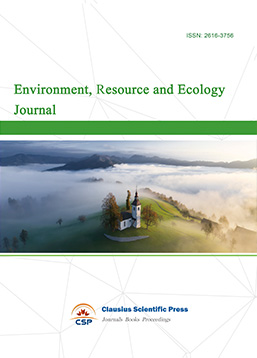THE INFLUENCE OF VARYING COMPOSITION OF SOIL SAMPLES ON WATER FLOW RATE (2MM SHARP SAND 1MM MEDIUM SAND)
DOI: 10.23977/sesp.2018.11001 | Downloads: 35 | Views: 6457
Author(s)
Edeye Ejaita 1, Ogobiri Godwin 1
Affiliation(s)
1 Physics Department, Niger Delta University, Wilberforce Island Amassoma, Bayelsa State Nigeria.
Corresponding Author
Edeye EjaitaABSTRACT
Two different soil samples (sharp and medium) sand of (100% sharp to 0% medium) and (0% sharp to 100% medium) sand were used for this research work and gotten from a sand dredging site at Amassoma community, Bayelsa State, Nigeria. These soil samples were heated differently in an oven to a temperature of 120oc to remove moisture and allowed to cool to room temperature of 30oc. The soil samples were sieved with suitable sieves of about 1mm for medium sand and 2mm for sharp sand respective. Mixtures were then grouped into seven (7) groups with different percentages by weight in this order (100% sharp to 0% medium), (80% sharp to 20% medium) down to (0% sharp to 100% medium). Each soil samples were poured into a transparent P.V.C. pipe with a sieve attached at the bottom of the pipe. 800ml of water was allowed to flow through these soil samples and the time of first drop was timed (Tf), using a stop watch. Volume of water received (Vrc) and volume of water retained (Vrd) were determined using a measuring cylinder. Also, the average flow rate (Uav) was obtained. The results from this experimental work shows that water flows through different soil samples at different flow rate as indicated in (fig.1 to fig.7.). Figure 2 shows an increase in volume of water with respect to time. As the percentage of medium sand increases (thereby leading to a decrease in the pore spaces), the volume of water retained and time of first drop increased as well as shown in (fig.3 to fig.7). Figure 8 shows an Histogram indicating a marginal difference between the flow rate in the dry and wet soil samples. The marginal difference between the wet and dry curve is most significant at the percentage composition of sample (60% sharp and 40% medium sand).
KEYWORDS
Flow Rate, Time of first drop, Soil Sample, Porosity.CITE THIS PAPER
Edeye, E., Ogobiri, G., THE INFLUENCE OF VARYING COMPOSITION OF SOIL SAMPLES ON WATER FLOW RATE (2MM SHARP SAND 1MM MEDIUM SAND). Solid Earth and Space Physics (2018) 1: 1-11.
REFERENCES
[1] Adesunloye, M.O. (1989). Investigating problem soils of Nigeria. 9th regional conference on soil mechanisms and foundation Engineering for Africa. 1, 105-112.
[2] Amer, A.M. (2002). Drainable and water filled pores as related to water storage and conductivity in agricultural soils of Nile Delta. Verb internal Verein, Limnology. 28(4), 1912-1919.
[4] Frankel, H.J, Goertzan, o. and Rhoads, J.D. (1978). Effects of clay types and content and soil hydraulic conductivity. California: Standford University. 42,32-39.
[5] Hermanz, J. L., Pixoto, H., Cerisola, C. and Sanchez, V. (200). Predicting soil density soil profile in field condition sing penetration resistance, moisture content and soil depth. 93,167-184.
[6] Kerman, P.J., Ritz, R.W., Dominiji, D.F and Conrad, C.M. (2007). Porosity and permeability in sediment mixtures groundwater. 45(4), 429-438.
[7] Leeper, G.W. and Uren, U.C (1993). Soil Science – an introduction (5th ed). Melbourne: Oxford University press.
[8] Mohanty, K.K and Salter, S.J (1982). Multiple flow in porous media, 5th annual tech. conference Dallas 1:21.
[9] Mitchell, J.K (1995) fundamentals of soil behavior. New York: John and Sons. 118-120.
[10] Salt, P.J., Berry, G. and Williams, J.B (1996). The influence of texture on the moisture characteristics of soils. Melbourne: Oxford University Press. 19,93-98.
[11] Velde, B. (1995). Composition and mineralogy of clay minerals in Velde, origin and mineralogy of clay. New York: Springer Verlog. 8: 42.
| Downloads: | 35 |
|---|---|
| Visits: | 6457 |
Sponsors, Associates, and Links
-
International Journal of Geological Resources and Geological Engineering

-
Big Geospatial Data and Data Science

-
Environment and Climate Protection

-
Journal of Cartography and Geographic Information Systems

-
Environment, Resource and Ecology Journal

-
Offshore and Polar Engineering

-
Physical and Human Geography

-
Journal of Atmospheric Physics and Atmospheric Environment

-
Trends in Meteorology

-
Journal of Coastal Engineering Research

-
Focus on Plant Protection

-
Toxicology and Health of Environment

-
Geoscience and Remote Sensing

-
Advances in Physical Oceanography

-
Biology, Chemistry, and Geology in Marine

-
Water-Soil, Biological Environment and Energy

-
Geodesy and Geophysics

-
Journal of Structural and Quaternary Geology

-
Journal of Sedimentary Geology

-
International Journal of Polar Social Research and Review


 Download as PDF
Download as PDF